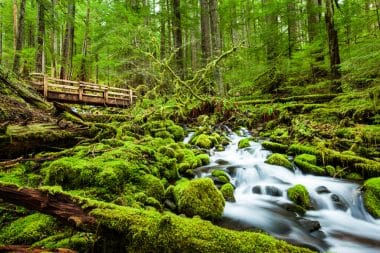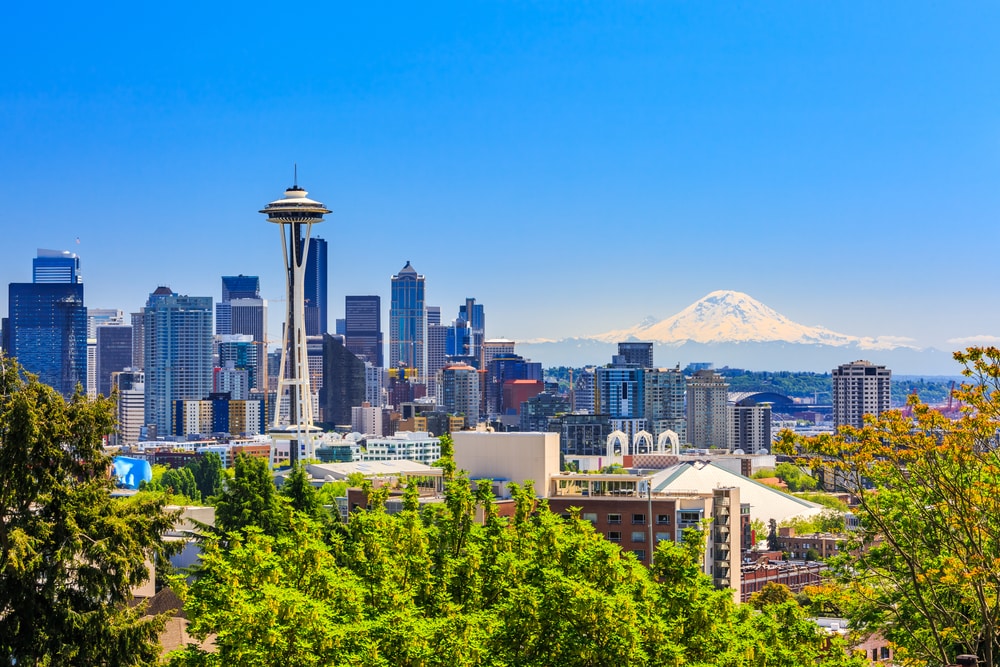George Washington’s face was not only immortalized in Mount Rushmore and his name not only in the US capital: In the far northwest of the USA, one of the most fascinating natural regions in the United States awaits with the state of the same name. Mount Rainier and Mount St. Helens are just two reminders of the region’s breathtaking natural forces, which have their own monuments and parks dedicated to them. Puget Sound, Olympic National Park and the North Cascades National Park complete the natural panorama of Washington. But the state in the northwest of the USA does not only consist of nature – over seven million people have a home here. About half of them in the Seattle metropolitan area: The Emerald City forms an urban highlight of Washington that unfolds in front of the face of Mount Rainier.
Seattle and co. – Urban and regional Washington
If you count the mere number of inhabitants of the US metropolises, Seattle (730,000) is not even one of the fifteen largest cities. But the bustling metropolitan area of over 3 million people and an exposed location on the route between Canada, Oregon and California make Seattle an absolute hotspot on the American West Coast. The city also stands out as a tourist gateway to the region’s natural attractions – not far from Mount Rainier, Puget Sound and Olympic National Park. A world-famous landmark is the Space Needle, the more than 180-meter-high observation tower in the heart of the Seattle skyline – once built for the 1962 World’s Fair. As the home of the grunge sound from Nirvana to Pearl Jam to Soundgarden, the city has long been an influential source of creativity. Today, institutions such as the Seattle Art Museum with important North American and international works of art or the extremely fascinating Museum of Pop Culture including the Science Fiction Museum and Hall of Fame remind us of Seattle’s importance as a modern cultural center. In terms of tourism, the city between Puget Sound and Lake Washington is at the top of the list of sights worth visiting in Washington.
But the state in the northwest of the USA has much more to offer from an urban perspective than just Seattle. About 50 km south of the metropolis unfolds the urban Tacoma. Here, cultural highlights such as the Tacoma Art Museum and the Museum of Glass await. Downtown Tacoma is known for its Museum District, which boasts cultural institutions of national and international standing. The second largest city in Washington, even ahead of Tacoma, is Spokane, located in the east of the state. Here you can discover Spokane Falls and the Northwest Museum of Arts and Culture. Spokane is also known for regional breweries and well-visited golf courses in the region. And at the gates of Olympic National Park, the city of Port Angeles awaits, which forms an important starting point for the natural region of Washington. Not far from the city, the natural panorama of Hurricane Ridge unfolds, known for its bombastic mountain scenery.
Olympic Mountains and Mount Rainier – Nature and National Parks of Washington

Urban Washington, especially Seattle, has a few highlights to offer for fans of high-quality sightseeing. But Washington’s nature brings an incomparable tourist splendour to the region. State parks, national monuments and national parks characterize Washington’s natural formations. Of the three national parks, Olympic National Park is one of the most visited, and has been a UNESCO World Heritage Site since 1981. On the coast of Washington lies the eponymous Olympic Peninsula, which is mainly characterized by the Olympic Mountains, glaciers and rainforest. Here rises the 2432-meter-high Mount Olympus, the largest mountain in the region. The largely untouched natural world of the Olympic Mountains spans about 4,000 km² – in which a wide variety of animal species feel at home, from the rare spotted owl to golden eagles and gray whales, which present themselves on the coast of the park in the appropriate season. Not only the mountains, scenic hiking routes and a breathtaking coastline characterize the park, which is one of the highlights of Washington.
In the middle of the national park of the same name rises Mount Rainier, which is considered the highest volcano in Washington at 4,392 meters. The history of the national park dates back to 1899, which, like the Olympic National Park, lives from its untamed wilderness. In addition to the volcano, the many waterfalls are characteristic, including the famous Myrtle Falls in front of the panorama of Mount Rainier. The region is also home to North Cascades National Park, which is characterized by the same cascade chain that includes Mount Rainier. Washington’s three national parks alone prove the natural wealth that lies dormant in the northwestern US state. At the same time, natural formations such as the Mount St. Helens National Volcanic Monument are located here. Waterfalls like Snoqalmie Falls show that you don’t have to travel deep into a national park to see such natural sights in Washington. Snoqualmie Falls was once immortalized in the famous TV series Twin Peaks. And if you want to see the scenic and natural Washington far away from mountains, volcanoes and waterfalls, you can also discover the San Juan Islands, which are a paradise for whale watching in the right season. Whether Seattle or the national parks on Mount Rainier and the Olympic Mountains – Washington is the best proof that a very special tourist adventure awaits between California and Canada on the American west coast.


